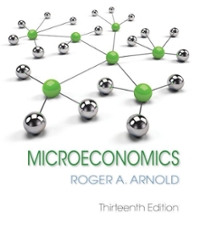The town adjacent to my own has just implemented tighter pollution standards. It turns out that, as
Question:
The town adjacent to my own has just implemented tighter pollution standards. It turns out that, as a result, the air quality is better in that town than in the town I live in. I think that people moving into the area are going to prefer to live in the town with better air than in my town.
Hear what and how the economist thinks:
If everything between the two towns is the same except that one town has better air quality than the other, the person is right: people who move into the area will probably prefer to live in the town with better air.
But this may not continue forever. Let’s say that towns A and B are alike in all ways, except that town A has better air quality than town B. As a result, when deciding where to live, people moving into the area would probably see more benefits per \($1\) by moving into town A than B. But those who move into town A end up increasing the demand for housing in the area, and, eventually, house prices rise in town A relative to house prices in town B. Yes, there will be higher air quality in town A, but individuals will have to pay for it by paying higher prices on housing. (We discuss this phenomenon in our feature, “How You Pay for Good Weather.”)
What people often do not see, because it is often difficult to see, is that even though people do not directly pay for something that they want, that does not mean that they won’t end up paying for it indirectly.
In our example, no one comes around to the residents of town A and says that they each owe \($100\) a month for cleaner air. But that doesn’t mean that people do not indirectly pay for the cleaner air. If, because of cleaner air, the demand for the houses in town A rise, the price of clean air will get incorporated into housing prices in town A.
It’s been said that one of the jobs of the economist is to make what is invisible, visible. When the economist points out how we can end up paying for things that do not have a literal price tag attached to them, this is what he or she is doing.
For another example, let’s think back to our discussion (in an earlier chapter) on price ceilings. Suppose the equilibrium price of a good is \($4\) per unit, and then the government imposes a price ceiling of \($3\) on the good. For many people, nothing will change other than they will end up paying less for the good instead of more—all benefits, no costs. However, the economist says that, because of the below-equilibrium price, both the quantity supplied and quantity demanded change. The quantity supplied falls (if the supply curve is upward-sloping) and the quantity demanded rises. Because of this, there is a shortage. And because of the shortage, there needs to be some rationing device other than price (since there is a ceiling on price) to deal with it. As a result, we get non-price rationing devices, such as first-come, first-served. Oftentimes, what happens after the price ceiling has been imposed is invisible to many people. The economist’s job is to make what comes after the price ceiling visible.
Questions:
1. State governments will often rank the public schools in the state. Would you expect housing prices in neighborhoods where top-rated schools exist to be higher than in neighborhoods where low-rated schools exist? Explain your answer.
2. Real estate prices in New York City, especially Manhattan, are higher than real estate prices in Lake City, Florida (a city of about 12,000 people), although most people would likely consider the weather better in Lake City than in New York.
Does this prove that people do not indirectly pay for good weather in housing prices? Explain your answer.
Step by Step Answer:






